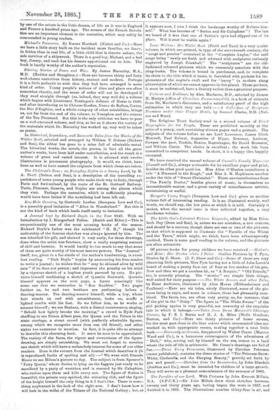unquestionably one of the most amusing books of the season.
Richard Doyle's father was the celebrated " H. B.," though his authorship of the famous sketches was always ignored by him. The son inherited his gift, and showed it very early, for these drawings, done when the artist was fourteen, show a really surprising amount of skill and humour. It would hardly b3 too much to say that some of them are quite worthy of his most mature powers. The "Journal" itself, too, given in a fac-simile of the author's handwriting, is excel- lent reading. "Dick Doyle" begins by announcing his firm resolve to write a journal ; he wishes that he " may be skinned alive by wild cats" if he does not persist; and impresses the penalty on his mind by a vigorous sketch of a hapless youth pursued by cats. He pic- tures himself meditating a sketch of Quentin Durward. Quentin himself appears on the next page, a figure amazingly like some one that we remember in " Bon Gaultier." Two pages
further on, he and two brothers are performing before a dancing-master. The dancing-master himself, while a boy, whose
hair stands on end with astonishment, looks on, snuffs a lighted candle with his foot. So we follow him, as he works or amuses himself ; we see Braham, with a dismal countenance, singing, "Behold how lightly breaks the morning," a crowd in Hyde Park shuffling to see Prince Albert pass, the Queen and the Prince in the state carriage, a street crowd (with perfectly admirable figures, among which we recognise more than one old friend), and other sights too numerous to mention. In fact, it is quite idle to attempt to describe this charming book. It mast be seen to he appreciated. The variety of the faces, the vigour and correctness of the figure- drawing, are simply astonishing. We must not forget to mention one sketch which will have a melancholy interest for some of our older readers. Here is the extract from the Journal which describes it (it is reproduced, faults of spelling and all) :—" We went with Francis Moore to see Hilton's picture to-day. The subject is from Spencer's Fairy Queen,' where Serina is lying on the faggots just ready to be sacrificed by a party of wretches, and is rescued by Sir Calaphine, who rushes upon them and kills every one. The figure of Serina is beautiful, the priests very spirited, the colouring rich, and the figure of the knight himself the only thing in it I don't like. There is some- thing unpleasant in the look of the right arm. I don't know how it will look in the midst of the Titians of the National Gallery ; but, as it appears now, I own I think the landscape worthy of Rubene him- self." What has become of "Serina and Sir Calaphine" ? The last we heard of it was that one of Serina's eyes had slipped out of its place. Will it ever be visible again


































 Previous page
Previous page